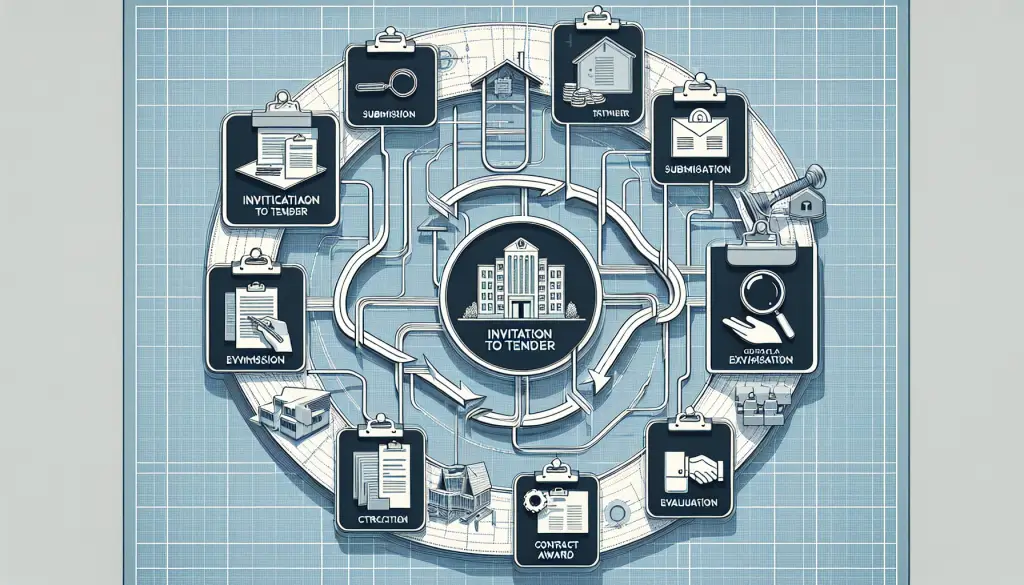15 Essential Construction Company Roles & Their Responsibilities
September 23, 2024
Are you looking to understand the building construction tender process? This article will guide you through what a building construction tender is, why it’s essential, and the key steps you need to follow for success. Whether you’re a contractor aiming to submit competitive bids or a property owner seeking the best quality work, our comprehensive overview will provide the knowledge you need.

The tendering process stands as a fundamental aspect of the competitive bidding system prevalent within the construction industry. It consists of an official proposition to contractors inviting them to present their proposals for executing a specific construction project. More than just securing projects, this procedure serves as a platform for companies to demonstrate their expertise and commitment to providing quality outputs.
Entailing numerous critical stages such as soliciting tenders, submitting tenders, selecting appropriate tenders, forming contracts, and ultimately delivering on the project commitments ensure that construction tenders are systematically managed from initiation through completion.
In the context of construction, a ‘tender’ is an official invitation issued for the procurement of services or goods in which contractors present competitive proposals to undertake a construction project. This formal procedure, identified as tendering, allows potential contractors to showcase their capabilities and propose their qualifications for being awarded the contract.
The objective behind this structured approach is to acquire options that offer the best economic value for a given construction project by engaging interested contractors in submitting their bids.
The tendering process is indispensable in the construction industry because it creates a competitive landscape that allows only the most qualified contractors to prevail. It stimulates competition regarding costs, guarantees quality workmanship, and enables construction companies to land substantial contracts which are key for their expansion. The reputation of a company significantly influences its chances of winning tenders, with those holding better reputations Achieving more wins.
Transparency and fairness are hallmarks of the tendering process, bolstering cooperation and confidence among project proprietors and contracting firms. Effective strategies in tendering not only enhance cash flow but also drive efficiency and stimulate innovation amongst contractors – factors that contribute positively to the final results of projects.

The construction tendering process is a methodical system aimed at drawing in capable contractors to undertake construction work. This multifaceted procedure navigates the path from recognizing a project through the stages of engaging in construction tendering and onward to carrying out the contract.
Grasping each phase of this procedure is essential for contractors who aspire to present compelling proposals and win construction contracts successfully.
The tendering process is initiated with an Invitation to Tender (IFT), a formal document issued by property or project owners requesting goods or services. The IFT contains detailed information about the project such as its scope, budget, and timeline.
In public sector projects, open tendering is frequently employed as it promotes transparency by welcoming bids from all contractors who are interested in participating.
Contractors must meticulously prepare their tender documents, ensuring they are comprehensive, precise, and in line with the specifications set forth by the client during the submission phase. These documents ought to include explicit conditions that determine whether prospective suppliers qualify.
It is critical for contractors to correctly interpret the specifications provided as misinterpretation is a primary cause of tender failures. This necessitates a thorough preparation and understanding of all necessary documentation required for submission.
During the assessment phase, tenders undergo an evaluation based on established criteria to guarantee equitable comparisons. Experience and cost are the main areas where contractors vie for selection. It is incumbent upon the owner or other relevant entities to choose the most favorable tender, with a focus on both bid quality and competitive edge.
Although selective tendering might result in elevated bids and there’s a risk of partiality, it guarantees that consideration is given only to those contractors who have been pre-qualified.
After the assessment process concludes and a winning bid is identified, both the project owner and the chosen contractor work together to establish a construction contract. This agreement clearly defines each party’s duties and anticipations.
In an activity known as contract engrossment, this ultimate agreement undergoes preparation for finalization. It includes meticulous examination followed by signatures from both involved parties. Accomplishing this step guarantees that the project advances seamlessly with defined directives and concordant consent.

In the construction industry, various tendering methods exist that are appropriate for diverse project circumstances and needs. Contractors who grasp these methods can better select their bidding strategies, thereby improving their prospects of securing tenders.
The open tendering process offers an invitation for bids that is available to all interested contractors, fostering a climate of competition and clarity. This strategy cultivates a competitive tender atmosphere by allowing any contractor who wishes to submit a proposal the opportunity to do so.
This methodology ensures impartiality in awarding opportunities to various contractors. One potential drawback is the excessive number of proposals might lead to extended selection periods. The public sector frequently employs open tendering because it stimulates bidders’ competitiveness which can result in lower project costs.
Selective tendering entails inviting a small number of contractors, who have been pre-selected based on certain criteria outlined in pre-qualification questionnaires, to submit bids. This ensures that only those companies meeting specific requirements are allowed to participate.
The objective of this approach is to confine the bidding process to a shortlist of contractors that have already demonstrated their qualifications. By doing so, it minimizes the chances of receiving subpar proposals and promotes competition at a higher standard.
The process of negotiated tendering involves a client inviting tenders from only one or a limited group of contractors, with whom they then directly negotiate the cost. The use of this method is appropriate for unique projects that have limited suppliers available or when there are stringent time constraints to adhere to.
While it can lead to substantial cost savings and accelerate project timelines, in certain instances, the practice may be viewed as reducing competition.

Combining meticulous planning with articulate writing is key to successful tender preparation, aiming to increase the chances of securing bids. Employing tools for construction management can elevate both precision and productivity in crafting tender submissions, guaranteeing that all necessary details are comprehensively included and conveyed professionally.
The tender documents should include essential components such as the scope of the project, cost estimates, and schedules. It is crucial to have precise specifications within these documents that detail the exact needs, deadlines, and pricing forecasts for the project.
Tender documents must contain contract terms that clearly articulate both parties’ obligations and privileges, those of the client and those of the contractor. Price arrangements must be transparently outlined in these documents to ensure a fair balance between being economical for clients and allowing contractors profitable returns reflective of current market conditions.
One common mistake during the preparation of a tender is the failure to thoroughly review and comprehend the criteria specified in the tender documents. Overlooking these detailed conditions can adversely affect a submission for a tender. Neglecting to properly edit for mistakes and maintain uniformity in formatting may leave evaluators with an unfavorable view.
To prevent being disqualified, contractors are required to submit sufficient documentation that establishes their qualifications according to the terms outlined in those documents.

Securing contracts through construction tenders involves adopting a tactical method that encompasses offering competitive bids, showcasing expertise, and making use of technological advancements. These top strategies enable contractors to differentiate themselves in the fierce competition and enhance their likelihood of winning tenders.
Bids of superior quality are crucial because they showcase the contractor’s proficiency in supplying goods, works, or services that meet high standards. When contractors opt to present alternative bids with more cost-effective solutions, it is imperative for them to also include a proposal that complies with the original requirements.
It’s important for pricing approaches to strike a careful equilibrium between generating profit and maintaining market competitiveness so that proposals remain both appealing and practical. An effective approach to tenders melds aggressive price points while highlighting previous experience on similar projects.
Referencing previous projects that are comparable in terms of size and complexity to the tender can greatly improve submissions, instilling confidence in potential clients. Contractors ought to emphasize measurable achievements like budget efficiency and adherence to deadlines from these similar endeavors.
Incorporating comprehensive case studies within a submission serves as robust proof of prior success and competence. Cultivating solid rapport with clients may lead to an increased likelihood of securing winning tenders.
Construction management software plays a vital role by delivering essential updates to construction documents, which greatly refines the tendering process. The use of cloud-based platforms allows for immediate collaboration between team members, which increases the speed and precision of preparing tenders.
Market Intelligence tools are instrumental for contractors as they keep track of their competitors within the realm of tender opportunities. These tools offer critical data that helps contractors craft more informed and competitive bids during the tendering process.
Deux Project stands out as a model of effective tendering within the construction industry. By skillfully blending negotiation tactics with open tendering, they have managed to secure both competitive and high-quality bids, leading to considerable successes in acquiring projects.
With a rich history spanning three decades, Deux Project Limited excels in bolstering infrastructure and social amenities by collaborating with both public and private sectors within Nigeria. Their expertise encompasses an array of construction projects along with ventures in oil and gas, social infrastructure developments, initiatives at federal and state levels, marine operations, as well as the power sector.
Deux Project is adept at offering holistic facility management services that prioritize efficiency, upkeep, and safety from inception to completion. These services are comprehensive covering groundwork such as designing foundations to structural construction. They extend even into erecting buildings complete with mechanical systems installations. Through their rigorous approach to managing construction processes successfully end-to-end—clients receive fully integrated turnkey solutions.
Deux Project has demonstrated its expertise in handling complex projects by successfully constructing 20 hospitals, renovating upwards of 50, and equipping more than 200. To healthcare facilities, they have built a total of 10 schools, rehabilitated more than two dozen, and provided equipment for another score or more. The company’s proficiency is Exemplified by the construction of four stadiums as well as the rehabilitation of one.
The myriad achievements underscore Deux Project’s adeptness at navigating effective tendering processes while making substantial impacts within the construction sector. If you would like any assistance with your next construction project be sure to contact us!
Project owners issue a construction tender as an official request for contractors to present their bids on a particular construction project. This vital step helps in obtaining the most favorable proposals and guarantees competitive pricing in the process.
In the construction industry, tendering plays an essential role by promoting competitive pricing and guaranteeing quality assurance. This practice is key for businesses to obtain important contracts that contribute to their expansion.
The procedure is integral in realizing efficiency and success within construction projects, proving its fundamental importance.
Each phase of the tendering process is vital for securing and fulfilling contracts effectively, including the issuance of an invitation to tender, submission of tenders, assessment of submissions, and ultimately awarding and executing the contract.
Common types of construction tenders are open tendering, selective tendering, and negotiated tendering.
Each method serves specific project needs and stakeholder preferences effectively.
By employing competitive pricing strategies, highlighting their expertise and competencies, as well as adeptly using technology, contractors can substantially improve their likelihood of securing tenders.
Together, these factors create a robust proposal that captures the attention of those responsible for making decisions.
September 23, 2024
September 18, 2024
August 26, 2024